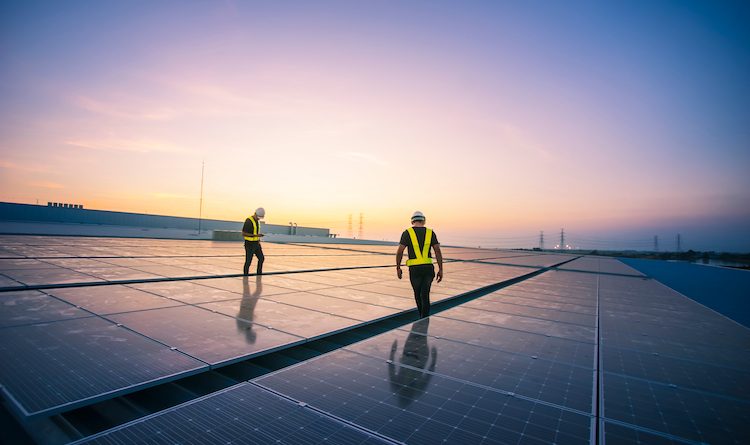Why battery storage is key to making the most of solar PV
Over the past two years, many industries have been hit by the global rise in energy prices. This is particularly true of energy intensive sectors such as manufacturing, which have struggled to manage the increased cost of energy alongside additional financial challenges, such as rising inflation and supply chain disruptions.
Many governments across the world put in emergency measures to support major energy users during the energy crisis. For example, in the UK, the Energy Bill Relief Scheme and subsequent Energy Bills Discount Scheme were specifically designed to help high emitters manage their energy costs.
There were also specific initiatives to encourage investment in technologies to cut carbon emissions, which could be hugely beneficial to manufacturers. For

example, in his latest Budget, the UK’s Chancellor of the Exchequer announced plans to extend full expensing to leased assets, allowing businesses to get tax breaks when investing in major assets, such as plant and machinery that reduce emissions.
Without doubt, manufacturers will play a critical role in achieving net zero targets by implementing strategies to minimize their carbon footprint. Despite the economic challenges of the past few years, many are already taking positive and proactive action, through measures such as shifting demand to off peak times, reducing consumption through effective energy management strategies and achieving efficiencies through greater use of technology.
Another way that manufacturers are reducing both costs and carbon is by installing renewable onsite energy generation. From solar photovoltaic (PV) to wind, many are seeing the benefits of installing an onsite asset.
However, as the number of renewable onsite projects coming online increases, it is important that manufacturers take the necessary steps to ensure that their generation asset remains profitable.
The benefits of onsite solar PV generation
Solar PV is often considered one of the most accessible options for manufacturers as it can be installed on factory rooftops, car parks, warehouses and adjacent land. In fact, the UK government has recognized that the target of increasing solar PV generation to 70GW by 2035 will only be possible if it harnesses what it calls the ‘untapped potential’ of commercial solar PV assets.
Manufacturing and industrial organizations can benefit from onsite generation in several ways. After the initial investment has been paid, renewable energy generation assets have extremely low costs for producing electricity. Unlike fossil fuels such as gas or coal, there are no additional charges to source sunshine or wind. Once installed, the energy system can generate electricity at almost no expense, meaning that even at very low electricity prices, it is still profitable to generate renewable electricity onsite.
As well as a reduction in bills, businesses can benefit further by lowering their carbon emissions to support sustainability goals. They can increase their energy security by reducing their reliance on the grid for power, and any surplus electricity produced can be sold through a Power Purchase Agreement (PPA), providing an extra source of revenue.
Manufacturers can also benefit from an improved reputation as customers seek companies that demonstrate a more conscientious stance – whether that be socially, environmentally, or both. Making an active decision to generate renewable electricity onsite will help build a good reputation with both suppliers and customers.
Finally, many procurement departments now actively require certain environmental credentials from their suppliers to help them reduce their Scope 3 emissions, so having a renewable energy onsite asset could lead to winning new customers.
Future-proofing your asset with battery storage
Despite the benefits of onsite generation, businesses need to consider any potential barriers that may arise when implementing an energy system. For example, with an increased number of independent power generators exporting surplus power, the volatility of electricity prices has also increased over the past few years. At sunny and/or windy periods, an unprecedented amount of cheap renewable energy is entering the grid, and as a result we’re already seeing increased periods in Europe where the wholesale price of electricity is either zero or negative.
This is a phenomenon known as ‘solar price cannibalization’. If electricity prices are zero or negative, any electricity that is exported to the market and not locked into long-term PPAs has no value. In the future, this could mean securing a premium PPA could prove more difficult for generators.
Thankfully, there are relatively simple ways to avoid the negative consequences of solar price cannibalization. One way to future-proof renewable energy build outs and maximize return on investment is to add battery energy storage. This means that the energy generated onsite can be stored and used later to power operations, heat or cool business premises, charge EVs and more – rather than be sold to the market for little or no money.
Battery storage also allows businesses to store electricity for later use when simultaneous consumption and generation are not possible, such as during nighttime operations when there is no sunshine. This reduces manufacturer’s need to rely on the grid for surplus electricity during periods of no onsite energy generation. Additionally, battery storage allows for delayed exporting onto the grid to support peak demand when wholesale electricity prices are high.
Towards a self-sufficient future
Investing in renewable onsite energy is one of the most effective ways for manufacturers to mitigate the cost volatility of fossil fuels while also reducing emissions. However, when looking at the long-term return of a project, the cannibalization effect should be considered. As a result, when investing in renewable energy, it is vital to consider battery storage as part of a whole system solution.
By Stephan Marty
Stephan Marty is CEO at Wattstor. Wattstor designs, builds, pays for, operates, and optimizes onsite renewable energy systems, including renewable assets, battery storage and a powerful EMS. It works directly with commercial and industrial customers, their suppliers and utility partners, and with solar installers to 100 percen fund solar and battery project costs, so they get the electricity they generate at lower than grid cost.
